
Empididae is a family of flies with over 3,000 described species occurring worldwide in all the biogeographic realms but the majority are found in the Holarctic. They are mainly predatory flies like most of their relatives in the Empidoidea, and exhibit a wide range of forms but are generally small to medium-sized, non-metallic and rather bristly.

Empis livida is a species of fly in the Empididae family. It is included in the subgenus Kritempis of the genus Empis. Males range from 7.5 to 9.3 millimetres, females 7.5 to 10.2 millimetres. The male's abdomen is brownish and its wings appear faintly brown and clouded. The female's abdomen is gray and its wings are clear. E. livida lives in hedgerows, feeding on the nectar of several species of Rosaceae, several species of Asteraceae, and Heracleum sphondylium nectar; they also feed on other insects. They live all across temperate and Northern Europe, the only species with such a wide distribution. E. livida larvae are also carnivorous and live in damp soil and leaf litter. Adults fly in between April and July.

Empis is a genus of dance fly found in the fly family Empididae.
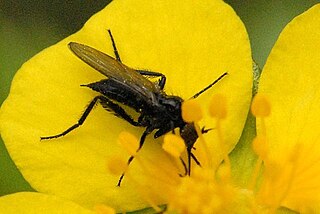
Empis planetica is a species of dagger flies, in the fly family Empididae. It is included in the subgenus Empis. It is found in Ireland and Great Britain and from Scandinavia south to Italy.

Empis ciliata, the black dance fly, is a species of dance fly, in the fly family Empididae. It is included in the subgenus Euempis.
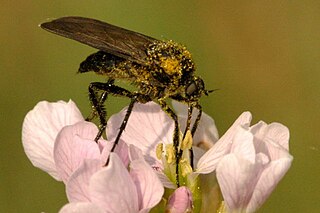
Empis tanysphyra is a species of dance flies, in the fly family Empididae. It is included in the subgenus Empis. It is found in most of central and southern Europe.
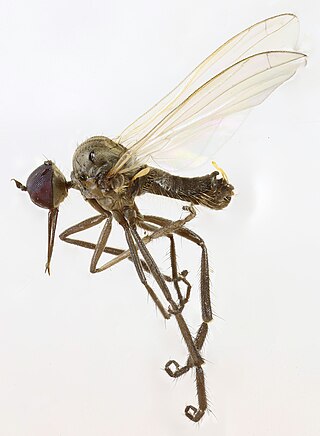
Empis albinervis is a species of fly in the family Empididae. It is included in the subgenus Coptophlebia of the genus Empis. It is found in the Palearctic.
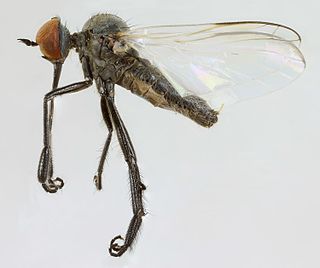
Empis chioptera is a species of fly in the family Empididae. It is included in the subgenus Empis. It is found in the Palearctic.
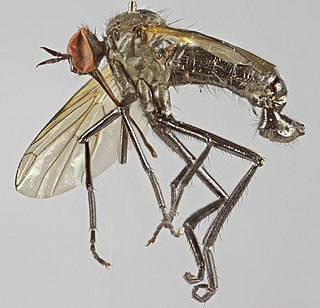
Empis lucida is a species of fly in the family Empididae. It is included in the subgenus Anacrostichus. It is found in the Palearctic. It is a large (8–10 mm.) shining black species.
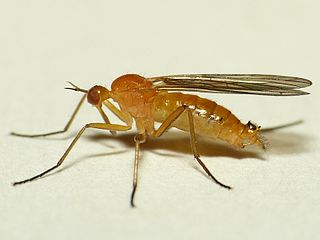
Empis lutea is a species of fly in the family Empididae. It is included in the subgenus Xanthempis. It is found in the Palearctic.
Empis impennis is a species of fly in the family Empididae. It is included in the subgenus Coptophlebia of the genus Empis. It is found in the Palearctic.
Empis prodromus is a species of fly in the family Empididae. It is included in the subgenus Empis. It is found in the Palearctic.
Empis sinuosa is a species of fly in the family Empididae. It is included in the subgenus Leptempis. It is found in the Palearctic.
Empis curvitibia is a species of fly in the family Empididae. It is included in the subgenus Lissempis of the genus Empis. It is found in the Palearctic.
Empis insularis is a species of fly in the family Empididae. It is included in the subgenus Lissempis of the genus Empis. It is found in the Palearctic.
Empis engeli is a species of fly in the family Empididae. It is included in the subgenus Polyblepharis. It is found in the Palearctic.
Empis adriani is a species of fly in the family Empididae. It is included in the subgenus Xanthempis. It is found in the Palearctic.
Empis dispina is a species of fly in the family Empididae and is included in the subgenus Xanthempis. It is found in the Palearctic.
Empis rohaceki is a species of fly in the family Empididae. It is included in the subgenus Xanthempis. It is found in the Palearctic.
Empis oxilara is a species of fly in the family Empididae. It is included in the subgenus Xanthempis. It is found in the Palearctic.








